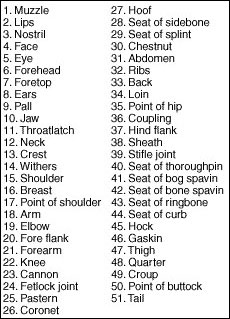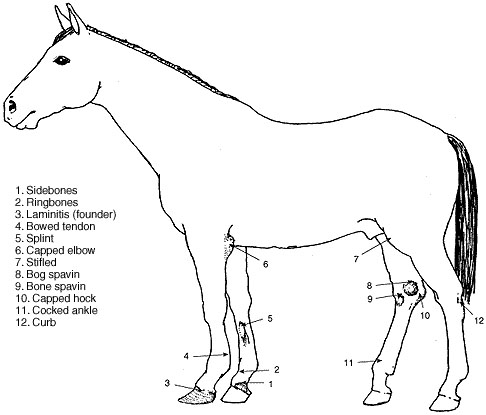Horses should be selected for a specific purpose. If the purpose changes, the horse may not be able to adapt to it. Some horses have great versatility, but none can excel at all of the activities required of horses. Although some overlap exists, these activities can be grouped into five general categories:
- Pleasure
- Breeding
- Working stock
- Show
- Sport
Pleasure horses include all types kept for the sheer joy of riding and ownership. Trail riding affords an excellent opportunity for relaxation, wholesome exercise and companionship with friends while riding scenic nature trails. A variety of pleasure classes in shows challenge the skill of both horse and rider in competition for ribbons and prizes.
Like most other horses, a pleasure horse spends most of its time under saddle at a walk. Therefore, it should have a prompt, fast, flat-footed walk of 4 or 5 miles an hour. A faster gait that is easy on both horse and rider is also essential.
Most accomplished riders started by riding pleasure horses.
Horse breeding as a business is highly specialized and requires considerable capital investment. Mares may have a low foaling percentage and they have a long generation interval, making the venture expensive. For these reasons, only superior animals should be mated.
In many breeding establishments, mares are not used for riding. However, they may perform normal work in early pregnancy and light work until about a month before foaling. A youth's experience in awaiting the birth of a foal and watching it grow to maturity is indeed a good one, although not always financially rewarding.
Working stock horses are in the unique position of being one of the few classes of horses used for essential purposes in this age in which machines and equipment have made inroads on tasks formerly assigned to horses. However, it is hard to imagine replacing horses completely on ranches and farms in the Southwest and mountain areas where large numbers of cattle are produced. Working horses are popular in the Midwest and in other beef-producing areas.
Western stock horses are essential for the sport of rodeo. They are also responsible for most growth in numbers of pleasure horses in suburban and urban areas in the Midwest and East.
Show horses are defined as those kept mainly for competition in shows. They are shown at halter or vehicle or under saddle. To be winners, they usually require professional training and expertise in handling and management. However, many amateur show classes are available where modest competition exists. Some riders get great satisfaction from exhibiting, whether they win or lose. Those who feel they must win need to prepare themselves to face stiff competition when they decide to enter the horse showing business.
Horses used for sport include race horses, both running and harness, and rodeo and game horses (barrel racing, pole bending, polo, etc.). These are highly selected, expertly trained and superbly conditioned animals used for a single purpose. Race horses are not usually the type with which an amateur should begin an involvement in horsemanship.
Conversely, most western horse shows offer game classes where amateurs and others enjoy trying their skill and their horse's speed against the stopwatch in timed events.
Selecting a horse
After deciding the intended use for your horse, consider the following seven topics before making your selection.
Breed
There are 20 or more different purebred horse breeds in the United States. They differ in size, shape, color, disposition, conformation, ability and adaptability. Some are "specialists," excelling in a narrow field; others are "generalists," adapted to many tasks without being superior in specialized fields. None will be excellent in all uses to which horses are subjected.
If you want a parade horse, you may select for color and style, but these characteristics would contribute little to a working stock horse. Selection for speed would dictate certain breeds. Selection for gaits would eliminate others.
Although there are exceptions to almost any statement, it is seldom practical to select an individual horse to perform a duty not characteristic of its breed. You would do well to view a large number of horses performing the task well, and select accordingly from them.
If you desire an easy ride, you may prefer gaited horses. If maneuverability and "cow sense" are required, the western stock horse type may excel. Crossbred horses sometimes combine the fast, easy walk of one breed and the flexibility of another. They make good horses for sustained traveling such as trail riding.
Conformation
Conformation refers to physical shape and balance of component parts. "Good" conformation increases the probability that a horse can perform the functions characteristic of its breed for an extended period of time without becoming unsound, but it is not a guarantee. "Faulty" conformation may impair some activities and may predispose a horse to unsoundness.
Although horses vary in size by breeds from 200 to 2,000 pounds, some characteristics of good conformation are common to all of them (Figure 1).


The back and coupling should be short and strong. The croup should be long, well muscled and not too steep. The underline or belly must also be long if the shoulder is to have adequate slope. The shoulder should be long, adequately sloped, and surmounted with high, sharp withers that extend backward one-fourth the length of the back. Ample depth of body at fore and rear flank is necessary. A straight leg should be correctly placed on each corner of the body. Cannons should be reasonably short, forearms long, and pasterns sloped about 45 degrees. Bone should be flat and ample in size. Feet should be dense, deep, wide at the heels, and squarely set on the ground. The neck should be long, refined at the throat, and deep at the base to afford maximum balance and flexibility.
Wide, short heads with shallow mouths, large nostrils and large eyes are preferred. Masculinity in stallions and femininity in mares are highly desirable.
Quality should show in refinement of joints, hair coat, smoothness and blending of parts. Size, ruggedness and muscling should be expressed commensurate with breed requirements. Freedom from blemishes is preferred, and soundness is required.

Examine the horse for soundness of legs and feet at the walk and trot. Lameness in a front limb is indicated by a nod of the head when weight is placed on the sound limb. The croup drops when weight is shifted from a lame hind limb to a sound one. Pain in a front limb will be noticeable in a standing position by "pointing," that is, resting one front foot ahead of the other. Be able to identify ringbone, sidebones, bone spavins, curbs, splints, foundered hooves and "stocked" legs.
Back the horse and check for strain halt and general stiffness. Check the eyes carefully. Exert the horse and listen for roaring. Check for "broken wind" or too frequent breathing. Finally, satisfy yourself that the horse is not encumbered with any serious bad habit that would impair usefulness.
Age and size
Children should learn from a dependable horse. This usually means a reliable, older horse rather than one in training less than a year. Well-trained horses 5 years and older make good mounts for beginners. Much older horses are very satisfactory if they are sound. One common mistake is to buy a young horse, unbroken or "green-broken," or a nervous horse that the child cannot handle safely. A scared horse and a scared child make poor companions.
Children who have intense interest in horses and have an opportunity to ride and work with them under supervision frequently will develop rapidly in their mastery of horsemanship.
Size of horse and rider should receive consideration. Small children find tall horses difficult to saddle and mount. Small horses should not be asked to carry heavy riders and equipment. Twenty percent of its body weight is a substantial load for a horse to carry on long rides. Adult riders in gaited classes on appropriately sized horses make an attractive combination.
Disposition and vices
Some horses, like some people, have nervous dispositions. They should be handled by experienced riders. Some breeds are more docile than others. Certain uses to which horses are subjected encourage nervousness. Timed events may make horses nervous, and some become hard to control.
Some riders prefer more "spirit" in their horses. Frequency of riding tends to gentle most horses, and heavy grain feeding may increase "spirit" in sluggish animals.
Horses with vices that might be dangerous should be avoided. These vices include kicking, running away and bucking.
Fads
Fads allow many individual horses to command large prices, when in reality their usefulness is seriously limited by faulty conformation. Worse still, some are used extensively in the stud. Color patterns are major among these fads. Buyers will sometimes decide on color, purchase the animal, then find it is neither the right individual nor the right breed to meet their objectives. Good conformation is available in all colors and should be insisted upon.
Individuals from rare breeds often achieve popularity beyond their usefulness because they are scarce. Usually any breed that is consistently good is not scarce, although there may be exceptions.
Pedigree
When close relatives are considered, pedigree selection is extremely important when all other selection tools are used (conformation, training, feeding, etc.). A distant ancestor has a low probability of contributing much to an individual horse.
Generally speaking, pedigree selection receives more emphasis in race and show horses than in others. If a stallion consistently sires good horses, his services are worth more than those of a stallion that sires an occasional top horse and many ordinary ones.
Price
Last, but not least, is price. Sometimes, price is a prime consideration. In the long run, a minimum budget in buying a horse may not be economical. For example, one might have a minimum budget and not be able to find a horse with much resale value at that price. Another $100 might get you in a class of horse that not only would be a pleasure to ride but might increase in value with time.
Prices on "average" horses vary greatly by season, but the good ones are always in demand. The greatest selection of horses for sale is found in the fall or early winter. This is because of the cost of winter feed, the labor required for care and a subsiding of "horse fever" after the summer show season ends.
If use of the horse is established, if fads and biases are not present, and if one is willing to shop, a satisfactory mount can be found that will please the most discriminating buyer.